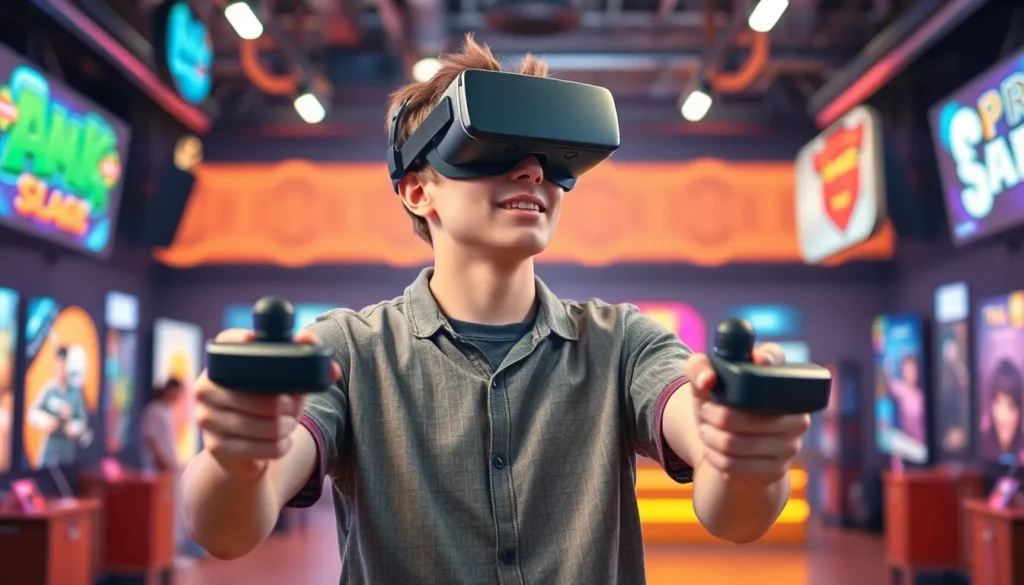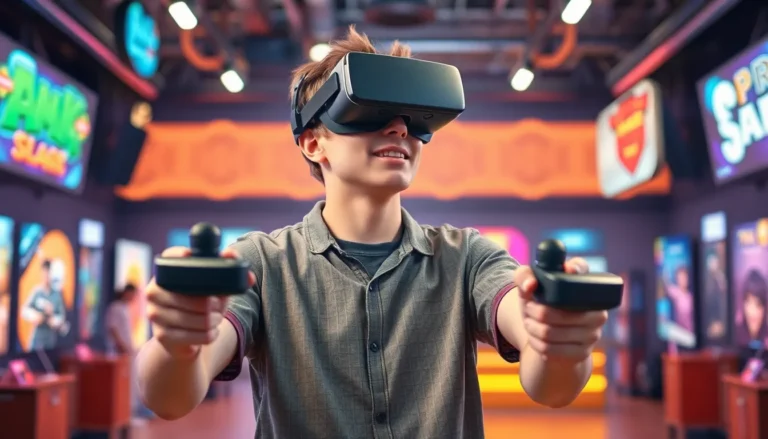Table of Contents
ToggleVirtual reality software is revolutionizing the way we experience everything from gaming to training simulations. Imagine stepping into a world where your wildest dreams come to life—without the need for a magic wand or a time machine. With VR, users can explore new dimensions, conquer virtual challenges, and even attend meetings in their pajamas. Who said work can’t be fun?
Overview of VR Software
VR software encompasses a variety of applications and technologies that create highly engaging virtual experiences. This software lets users immerse themselves in 3D environments, offering unique interactions and simulations. Various industries leverage VR software for training, marketing, and gaming, which enhances user engagement.
Gaming stands out as a primary use case for VR software. Popular titles like Beat Saber and Half-Life: Alyx showcase how immersive gameplay captivates audiences. Many game developers invest heavily in VR technology to provide players with realistic experiences.
Training applications utilize VR software to simulate real-life scenarios. Healthcare professionals can practice surgeries in a controlled environment, reducing risk. Companies in aviation use VR for pilot simulations, which improves safety and proficiency.
Marketing departments exploit VR software to create impressive brand experiences. Virtual showrooms allow customers to explore products in 3D, enhancing decision-making. Brands like IKEA use VR to showcase furniture in virtual spaces, allowing potential buyers to visualize products in their homes.
Education also benefits from VR software. Virtual classrooms allow students to engage with interactive lessons in immersive settings. Programs like Google Expeditions provide teachers and students access to virtual field trips, expanding educational possibilities.
Overall, VR software represents a pivotal advancement across multiple sectors. The growing accessibility of VR headsets has driven its adoption. As technology evolves, expectations for VR experiences continue to rise, fueling innovation in the software landscape.
Types of VR Software


Various types of VR software cater to different needs across numerous industries. This diversity enhances user experiences, making interactions more engaging and impactful.
Gaming Software
Gaming software stands as one of the most popular applications of VR technology. Titles such as Beat Saber and Half-Life: Alyx exemplify how immersive gameplay can captivate players. Players experience realistic environments that heighten engagement and excitement. Multiple platforms, including Oculus Rift and HTC Vive, host a wide range of games, appealing to diverse interests. VR gaming also enhances social interactions, allowing gamers to connect in virtual realms and enjoy cooperative challenges.
Educational Software
Educational software utilizes VR to create dynamic learning environments. Tools like Google Expeditions offer virtual field trips that transport students around the globe, enriching their understanding of various subjects. Interactive lessons foster engagement by allowing students to visualize concepts in 3D. Multiple educational institutions now incorporate VR in classrooms to enhance curriculum delivery. Teachers can track student progress in real-time, adapting lessons based on immediate feedback, which improves overall learning outcomes.
Training Simulations
Training simulations leverage VR to provide realistic learning experiences across various sectors. Healthcare professionals use VR for surgical training, allowing them to practice techniques in a controlled environment. Aviation companies employ simulative technology for pilot training, enhancing safety protocols and operational efficiency. VR simulations create scenarios that mirror real-life challenges, helping trainees develop problem-solving skills. Various industries benefit from this technology, leading to improved workplace performance and confidence in critical tasks.
Key Features of VR Software
VR software offers essential features that enhance digital experiences, making them more engaging and effective. Immersive environments create a unique sense of presence.
Immersive Experience
Immersive experiences form the backbone of VR software. Users engage with 3D environments that stimulate visual and auditory senses. Realistic simulations provide an unparalleled level of interaction. Multiple senses result in a heightened feeling of being part of the virtual world, whether through gaming, training or educational applications. Engaging scenarios captivate users, promoting deeper learning and retention. Social interactions grow richer, allowing people to connect beyond traditional methods. Dynamic elements elevate participation, transforming mundane tasks into captivating experiences.
User Interface Design
User interface design plays a crucial role in VR software effectiveness. Intuitive layouts facilitate navigation, minimizing learning curves. Visual elements adapt to users’ movements, ensuring comfort and fluidity. Context-aware interfaces present relevant information, preventing information overload. Gesture recognition and voice commands enhance interactivity, allowing users to engage naturally with the environment. Ergonomics guide the design of controllers and menus, ensuring ease of use during longer sessions. Consistency in design improves familiarity, promoting confidence and satisfaction while exploring virtual worlds.
Popular VR Software Options
A variety of VR software enhances virtual experiences across different platforms. These options cater to diverse needs, making VR accessible and enjoyable.
Oculus Software
Oculus offers a robust library of VR applications. Known for its user-friendly interface, Oculus software supports immersive gaming experiences like Beat Saber and Echo Arena. Developers benefit from the extensive tools provided by Oculus, enabling them to create engaging content. Social interactions thrive through Oculus Home, where users connect and share experiences with friends. Oculus Link allows seamless integration with VR-ready PCs for enhanced gaming capabilities.
HTC Vive Software
HTC Vive software excels in providing high-quality virtual reality experiences. A diverse range of applications exists, from gaming to educational tools. Viveport serves as the primary platform, featuring subscriptions for users to explore various software options. Enhanced room-scale technology enables users to move freely within the virtual environment, increasing immersion. Additionally, Vive’s compatibility with SteamVR broadens access to numerous titles and applications, ensuring endless entertainment.
PlayStation VR Software
PlayStation VR software brings console gaming into the VR realm. It features popular titles such as Resident Evil 7 and Astro Bot Rescue Mission, showcasing the potential for unique gaming experiences. PlayStation’s intuitive controls enhance usability, providing comfort during extended gaming sessions. The PSVR library continually expands, incorporating both exclusive titles and multi-platform options. Integration with PlayStation’s ecosystem allows for seamless user experience across devices, making VR more accessible to console gamers.




